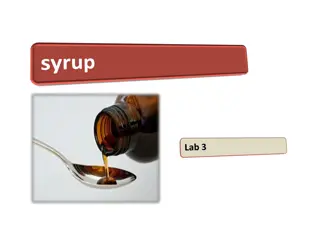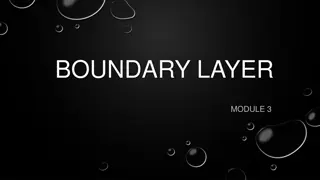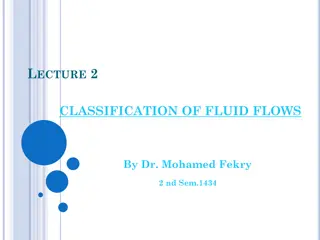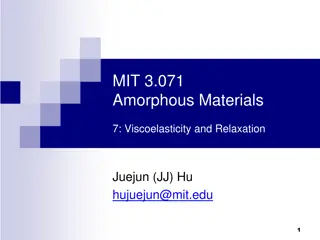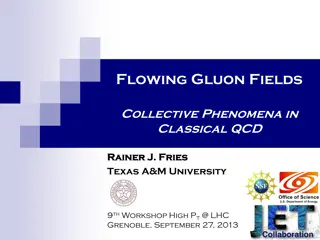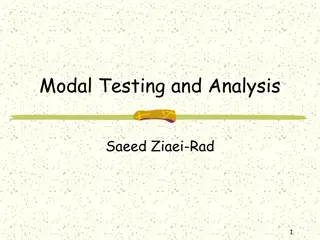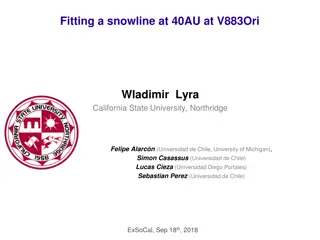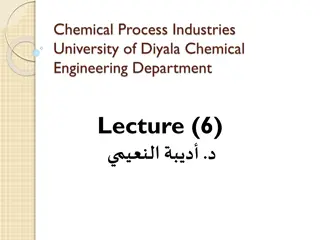Syrups: Types, Formulations, and Storage Considerations
Syrups are sweet, viscous liquids used in pharmaceutical preparations. They can be non-medicated for flavoring or medicated for therapeutic purposes. There are sugar-based and sugar-free syrups, with sucrose preferred for its purity and handling ease. Preservatives like benzoate and sorbic acid are
6 views • 16 slides
Boundary Layers in Fluid Dynamics
A boundary layer forms when a fluid flows over a solid surface, with viscous forces present close to the surface. It can be laminar or turbulent, determined by the Reynolds number. Flow separation occurs in adverse pressure gradients, affecting lift and causing drag. Efforts to delay separation incl
2 views • 19 slides
Non-Dimensional Numbers in Fluid Mechanics
Non-dimensional numbers play a crucial role in understanding fluid motion. This includes Reynolds Number for inertia and viscous forces, Froude Number for gravity effects, Cauchy Number for compressible flows, and Mach Number for elasticity forces. These numbers help in analyzing pipe friction, flow
1 views • 10 slides
Journal Bearings in Mechanical Design
Journal bearings play a crucial role in mechanical design by utilizing lubrication to minimize friction and wear between rubbing surfaces. This article explores the concept of lubrication, the wedge effect in journal bearings, methods to create a viscous layer, and the parameters affecting generated
6 views • 40 slides
Fluid Flows in Fluid Mechanics
Fluid Mechanics is the study of fluids in motion or at rest, and their interactions with solids or other fluids. Fluid flows are classified based on various characteristics such as viscous versus inviscid regions, internal versus external flow, compressible versus incompressible flow, laminar versus
1 views • 16 slides
Boundary Layer and Drag Forces in Fluid Dynamics
Boundary layer module explains the presence of viscous forces near a surface due to fluid flow, leading to laminar or turbulent boundary layers. Flow separation occurs when a boundary layer detaches from a surface, impacting lift and drag forces. Adverse pressure gradients and flow separation phenom
1 views • 19 slides
Viscoelasticity and Relaxation in Amorphous Materials
Dive into the world of viscoelasticity and relaxation in amorphous materials, exploring concepts like complex shear modulus, Maxwell element, and phenomenological models. Discover the intriguing nature of glass, its transition between solid and viscous states, and the various theories surrounding it
1 views • 34 slides
Flowing Gluon Fields and Color Glass Phenomena in QCD
Explore the collective phenomena of gluon fields in classical QCD, focusing on the Standard Model of URHICs, Color Glass, and Gluon Fields in the Forward Lightcone. The research delves into topics like local thermal equilibrium, viscous hydrodynamics, and the interaction of probes with quarks and gl
0 views • 24 slides
Fundamentals of Fluid Flow: Steady, Unsteady, Compressible, Incompressible, Viscous, Nonviscous
Fluid flow characteristics such as steady vs. unsteady, compressible vs. incompressible, and viscous vs. nonviscous play crucial roles in understanding how fluids behave in various scenarios. Steady flow entails constant velocities over time, while unsteady flow involves changing velocities. Liquids
2 views • 11 slides
Modal Testing and Analysis in Structural Dynamics
Modal testing and analysis play a crucial role in understanding the behavior of structural systems under various conditions like undamped, viscously damped, and hysterically damped scenarios. This analysis involves the study of single-degree-of-freedom systems, undamped systems for free and forced v
0 views • 23 slides
Silly Putty: Borax Concentrations and Material Properties
Created by mixing borax with glue, silly putty is a fascinating material with varying properties based on borax concentrations. Through a hands-on experiment, participants make different batches of silly putty to observe how high, medium, and low borax concentrations affect its texture and behavior.
0 views • 4 slides
Viscous Fluid Behavior in Engineering Applications
Viscosity is a crucial property in fluid mechanics, impacting how fluids deform and move. Engineers measure viscosity using factors like resistance to deformation and fluid behavior classifications such as Newtonian, shear thinning, shear thickening, and Bingham plastic. This knowledge is essential
0 views • 7 slides
Thermoplastics: Characteristics and Applications
Thermoplastics are solid at room temperature but become viscous liquids when heated, allowing them to be easily shaped into various products. They are pliable above a specific temperature and return to a solid state upon cooling. Commonly used engineering thermoplastics include Nylon, Polycarbonate,
0 views • 41 slides
Exploration of Snowline Dynamics in V883 Orionis System
Investigating the snowline position at 40 AU in the V883 Orionis protostellar system reveals insights into the accretion processes and heating mechanisms. Various studies analyze the properties of V883 Ori, its disk, and potential triggers for FU Ori outbursts. Observations highlight the signature o
0 views • 17 slides
Collective Excitations in QCD Plasma: Hydrodynamic Regime Overview
This research presentation by Ali Davody and collaborators from Regensburg University explores collective excitations in QCD plasma, focusing on chiral hydrodynamics, magnetic and vortical waves, hydrodynamic excitation descriptions, and modes derived from kinetic theory. The study delves into the d
0 views • 33 slides
Aerodynamics Fundamentals and Principles
Delve into the world of aerodynamics with an exploration of fundamental principles, equations, flow types, Mach number regimes, and vector relations. Discover the distinctions between inviscid and viscous flows, incompressible and compressible flows, as well as the various Mach number regimes from s
2 views • 17 slides
Journey to the Earth's Layers
The Earth's structure consists of four main layers: the crust, mantle, outer core, and inner core. The crust is the thin, rocky layer we see on the surface, while the mantle is a solid layer that flows like a viscous liquid. The outer core is a hot, melted layer of iron and nickel, and the inner cor
1 views • 10 slides
Fluid Flow: Steady vs. Unsteady, Compressible vs. Incompressible, Viscous vs. Nonviscous
Fluid flow can be categorized into different types such as steady or unsteady, compressible or incompressible, and viscous or nonviscous. Steady flow maintains constant velocity over time, while unsteady flow involves changing velocities. Liquids are typically incompressible, whereas gases can be co
1 views • 12 slides
Viscoelasticity in Materials
Viscoelastic materials exhibit properties of both elastic solids and viscous fluids, displaying time-dependent behavior under deformation. This unique behavior impacts various applications, such as device and structure design, emphasizing the importance of comprehending viscoelasticity. Real-life in
0 views • 10 slides
Chemical Process Industries at University of Diyala
Glass is a versatile material with various applications in daily life. It is made from natural raw materials and fabricated through processes such as blowing, drawing, and pressing. Different types of glass like soda-lime and potash-lime offer distinct properties for specific uses. The art of glass
0 views • 11 slides
PCBs Properties, Health Concerns, and Regulations Overview
Polychlorinated biphenyls (PCBs) are viscous liquids or solids used in various applications like construction materials, adhesives, and more. PCBs have raised health concerns due to their carcinogenic properties and environmental persistence. Manufactured in the U.S. from 1929 to 1979, PCBs are regu
0 views • 23 slides
Fundamentals of Aerodynamics in Aeronautics
This content delves into key topics of aerodynamics including the Navier-Stokes equation, boundary layer concepts, drag force, lift force, viscous flow, and effects of viscosity on boundary layers. It discusses drag prediction methods, boundary layer thickness, and the impact of viscosity on fluid d
0 views • 27 slides
Pilli (Fimbriae)
Bacterial pili, also known as fimbriae, and capsules play crucial roles in bacterial functions such as adherence, mating, and infection. Pili are hair-like structures on procaryotic cells, while capsules are viscous layers surrounding the cell wall. Pili aid in genetic transfer and pathogenic attach
0 views • 8 slides
Viscous Hydrodynamic Expansion of Quark-Gluon Plasma
Explore the viscous hydrodynamic expansion of the quark-gluon plasma for the color glass condensate in relativistic heavy ion collisions. Discussing models, results, and implications for QCD phenomena at hadron colliders.
0 views • 20 slides
Understanding Filtering in Turbulent Flows: Insights from Prof. Rob Stoll
Explore the concepts of filtering in turbulent flows from a lecture by Prof. Rob Stoll at the University of Utah. Learn about calculating 3D energy spectra, filtering equations for incompressible flow, and more. Discover the implications of applying filters to compressible Navier-Stokes equations an
0 views • 6 slides
Relativistic Viscous Hydrodynamics for Multi-Component Systems in Heavy Ion Collisions
Explore the application of relativistic viscous hydrodynamics in heavy ion collisions, focusing on the Quark-Gluon Plasma (QGP) and its space-time evolution. Learn about the formulation, results, and implications of this advanced hydrodynamic modeling approach.
0 views • 34 slides
Simulation and Analysis of Airfoil Flow for ENGR 2510 Mechanics of Fluids
Conduct a simulation of flow around an airfoil for the ENGR 2510 Mechanics of Fluids course. Explore concepts of boundary layers, flow separation, and compare Computational Fluid Dynamics (CFD) results with Experimental Fluid Dynamics (EFD). Learn about lift and drag forces, viscous flow, and the pr
0 views • 12 slides
Understanding Turbulence in Continuity Equation for Momentum
Explore the chaotic nature of turbulence in the solution of the continuity equation for momentum. Learn about the impact of pressure-gradient acceleration, inertial acceleration, viscous dissipation, and more. Delve into the transition from laminar to turbulent flow and the importance of subgrid sca
0 views • 7 slides
Understanding Total Hull Resistance in Ship Design
Learn about the total hull resistance calculations in ship design, including factors like air resistance, wave-making resistance, and viscous resistance. Explore how these components contribute to the total resistance a ship experiences during motion.
0 views • 30 slides
